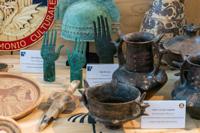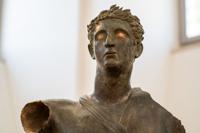Rome (CNN) � It looked more like a museum exhibition of Italian art than a crime scene, but in the Central Institute for Restoration’s offices, located inside a former women’s prison in central Rome, some 600 works of art were put on display Tuesday morning.
RangingĚýfrom life-sized bronze statues to tiny Roman coins,ĚýfromĚýoil paintings to mosaic flooring, the pieces span the 9th century BC to the 2nd century ADĚýand amountĚýto just one year’s stolen and trafficked art confiscated by Manhattan prosecutor Col. Matthew Bogdanosâ€� team and returned to Italy.
The trafficked works, pillaged from the Italian regions of Lazio, Campania, Puglia, Calabria and Sicily, were sequestered in New York and New Jerseyď»�Ěýlast year.
The returned works, together with 60 items repatriatedĚý, are worth more than $80 million (or roughly â‚�73.6 million) â€� but are just a drop in the bucket when it comes to artwork still hidden away in private warehouses and on display in museums in the United States, Bogdanos told CNN on the sidelines ofĚýaĚýpresentationĚýto the media on Tuesday.
Bogdanos said the $80 million of items does not include a further 100 items his team has just seized in the US.
What makes the seizure and return of stolen artifacts so difficult is that authorities often have no idea what they are looking for, according to Gen. D. Francesco Gargaro, commander of the Carabinieri for the Protection of Cultural Heritage.
“When artifacts are taken from clandestine graves, they have never beenĚýcataloged,â€� he said. That means that, in addition to the items themselves, their historical context was stolen, robbing archaeologists of valuableĚýinformation. (Instead,Ěýinvestigators work backwards, assessing paperwork and provenance claims for artifacts provided by their owners, as well as undertaking technical tests to best confirm a piece’s true origins.)
Most of the recent items returned to Italy were dug out of clandestine excavations or stolen from churches, museums and private individuals,ĚýGargaroĚýsaid.
Among the items on displayĚýon TuesdayĚýwas a cuirass and two bronze heads dating back to the 4th-3rd century BCĚýthat wereĚýconfiscated fromĚýaĚýgallery owner in New York.
There was alsoĚýan Umbrian bronze statue depicting a warrior stolen from an Italian museum in 1962Ěýthat wasĚýfound in a well-known American museum.
And a mosaic floor depicting the myth of Orpheus enchanting wild animals with the sound of the lyre from the mid-3rd to mid-4th century ADĚýwas recovered after beingĚýstolen from a clandestine excavation in Sicily in the early 1990s.ĚýIt wasĚýconfiscated from the private collection of a well-known New York collector.
Italy’s Carabinieri Cultural Heritage Protection unit uses artificial intelligence to search for stolen cultural assets under a new program called “Stolen Works Of Art Detection Systemâ€� (SWOADS), which searches forĚýtaken itemsĚýby scanning the web and social media for images.
“The return to Italy of cultural assets of such importance, both for their numerical consistency and for their historical-artistic value, is another significant achievement, Italy’s culture ministry undersecretary Gianmarco Mazzi said Tuesday.
“In addition to being works of art of inestimable value, they represent the high expression of our history, our culture and our national identity.�
In 2023 alone, 105,474 pieces of art worth more than â‚�264 millionĚý(or $287 million)Ěýwere found and confiscated worldwide thanks to the artificial intelligence project, according toĚýGargaro.
The-CNN-Wire
� & © 2024 Cable News Network, Inc., a Warner Bros. Discovery Company. All rights reserved.


















